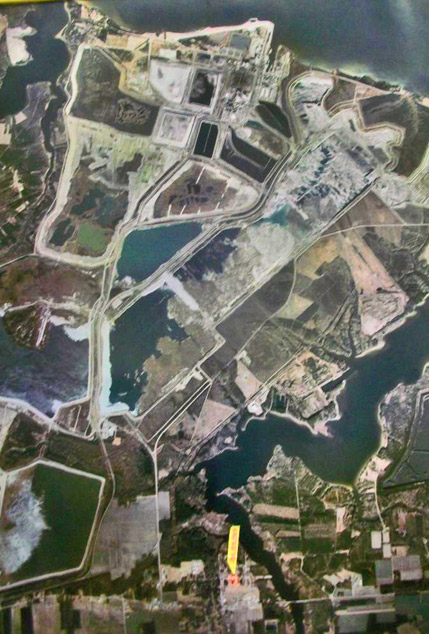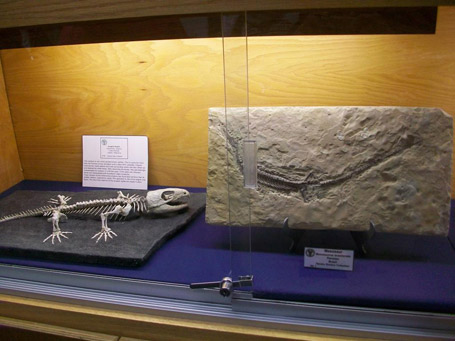|
This past spring we drove 2.5 hours north on HWY 17 through Jacksonville and New Bern to Aurora, NC. Its a tiny town almost on the Pamlico River/Sound. Just north of the town is a large phosphate mine that used to allow groups in, but no longer does. The museum gets a couple loads of material throughout the year for visitors to go through. The following aerial view shows the mine and the small yellow flag at the bottom is the museum and Aurora.
The following is an exerpt from the museum's website (http://www.aurorafossilmuseum.com/) on the geology of the region.
Pungo River Formation Brown (1958) first formally described phosphorite deposits in Beaufort County, N. C. He designated the phosphorite unit as being middle Miocene in age on the basis of foraminifera from the upper part of the unit that are correlative with foraminifera from the middle Miocene Calvert Formation of Maryland. Kimrey (1964) proposed the name, Pungo River Formation, for the phosphorite unit. The name is derived from the Pungo River near Belhaven, North Carolina. The formation is not known to outcrop so a core hole drilled near Belhaven in northeastern Beaufort County was used to designate the type section. The Pungo River Formation is primarily composed of inter-bedded phosphatic sands, and clays, limestones and dolostones. Riggs (1983) noted that individual lithologic horizons in the formation can be traced laterally and correlated based on grain size and percent P2O5 content. The Pungo River Formation unconformably lies above the Castle Hayne Limestone of Eocene age and is unconformably overlain by the Pliocene Yorktown Formation. The contact with the overlying Yorktown Formation as observed in cores, is sometimes gradational due to the reworked phosphatic material at the base of the Yorktown Formation. The thickness of the formation ranges from a thin edge in the western part of Beaufort County to more than 120 feet in eastern Beaufort County. The top of the formation dips generally to the east at a rate of about 10 feet per mile. The Pungo River Formation contains inter-bedded phosphatic sands, phosphatic - calcareous - diatomaceous clays, dolosilts and indurated limestones and dolostones.
Catty corner to the museum and next to the dig area is another part of the museum that holds some really interesting exhibits. I especially found the salt display amusing, with several hyalite crystals and a mound of white powder labeled "Morton"....
Tabby and Kevin had fun sorting out all their "loot" by size and species. I should have let her write about what species and such, as she has studied up and knows more about them than I do!
Tabby's next dream adventure would be SCUBA lessons and a dive trip to Fossil Ledge (30 or 40 miles off the coast) where megalodon teeth up to plate size can be found. We crossed off one bucket list item by going to the FL Keys and snorkeling Christ of the Deep. First pic is one from Fossil Ledge, along with many I've found in the gravel where I work. I've gone from looking for glints of green and blue to black and brown shiny smooth triangles.
|



























